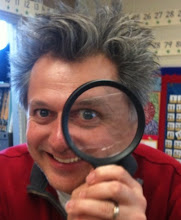Tuesday, February 23, 2010
Club Update
The club went very well last week. It was amazing to meet the new group of students. Their work was truly amazing. We talked a lot about the macro and micro scale. The students learned how to take notes in their science notebooks and justify their conclustions. Great work! The photos below show some of the students at work. This upcoming week we are going to look at Super Hydrophobic surfaces and we have a guest scientist who will join us from the University of Wisconsin-Madison. Dr. Tracy!
Monday, February 22, 2010
Sunday, February 14, 2010
MicroExplorers Club starts this Thursday.
MicroExplorers will start again this Thursday. I am so excited to start with another group of students. Every time I begin a new club, I wonder what path they will take and how I will lead them through their discoveries. Here is the plan that I have set up for the first day of club.
Introductions: There is a new group of students who may or may not know each other. I have pulled from various third grade classrooms at Leopold. The only direction I gave to teachers was to encourage two students from each classroom to join the club. If there were more than two kids who wished to join the club, a lottery system could be used to pick the students. Since one of the classrooms did not have students who wished to join the club, I had a couple of extra empty spaces that were filled by a few kids from other classrooms.
What is the smallest thing you can think of? I love starting with this question. It gives me so much information about the student’s prior experiences. Children’s ideas of scale are amazing. I will post their responses. If this group is like all the other groups I have worked with, the smallest thing they can think of will range from a dime to a grain of sand. It is truly a gift to introduce the microscopic scale to children at a young age.
What does a scientist do? In this portion of the lesson I gather a little more information about what a scientist does and I introduce science notebooks. Each child will draw pictures, write descriptions of what they know about scientists. Once again, I will use this to understand prior knowledge and start to get students understanding, and more importantly, misunderstanding. I will post scans of their work.
Microscopes and Inquiry: Then,I will introduce how to use the microscopes and lab safety. Each child will get a set of goggles and a lab coat. They will work in groups of three and use the microscopes to discover the identity of nine objects. I took pictures of everyday objects that I magnified from 10-200X. The students will need to match and justify their conclusions based on evidence. It is a really fun challenge to see the students have to justify their answers. I encourage the students to challenge themselves. Some of the objects look very similar. So, they really must have some solid evidence based on their observations.
Finally they will have to justify their results the other MicroExplorers. I like starting this from the first day. It becomes part of what we will do each day of the club. Conclusions must be based on evidence. I will post videos of the student justifications after the investigation.
Introductions: There is a new group of students who may or may not know each other. I have pulled from various third grade classrooms at Leopold. The only direction I gave to teachers was to encourage two students from each classroom to join the club. If there were more than two kids who wished to join the club, a lottery system could be used to pick the students. Since one of the classrooms did not have students who wished to join the club, I had a couple of extra empty spaces that were filled by a few kids from other classrooms.
What is the smallest thing you can think of? I love starting with this question. It gives me so much information about the student’s prior experiences. Children’s ideas of scale are amazing. I will post their responses. If this group is like all the other groups I have worked with, the smallest thing they can think of will range from a dime to a grain of sand. It is truly a gift to introduce the microscopic scale to children at a young age.
What does a scientist do? In this portion of the lesson I gather a little more information about what a scientist does and I introduce science notebooks. Each child will draw pictures, write descriptions of what they know about scientists. Once again, I will use this to understand prior knowledge and start to get students understanding, and more importantly, misunderstanding. I will post scans of their work.
Microscopes and Inquiry: Then,I will introduce how to use the microscopes and lab safety. Each child will get a set of goggles and a lab coat. They will work in groups of three and use the microscopes to discover the identity of nine objects. I took pictures of everyday objects that I magnified from 10-200X. The students will need to match and justify their conclusions based on evidence. It is a really fun challenge to see the students have to justify their answers. I encourage the students to challenge themselves. Some of the objects look very similar. So, they really must have some solid evidence based on their observations.
Finally they will have to justify their results the other MicroExplorers. I like starting this from the first day. It becomes part of what we will do each day of the club. Conclusions must be based on evidence. I will post videos of the student justifications after the investigation.
Wednesday, February 3, 2010
Subscribe to:
Comments (Atom)





